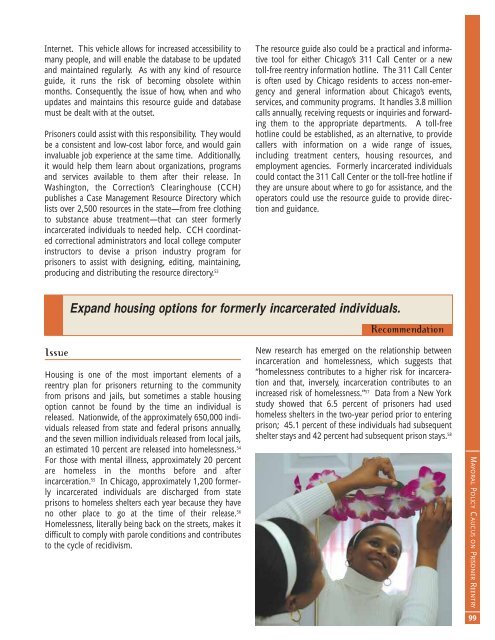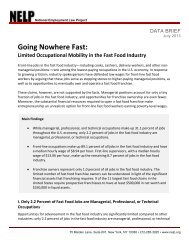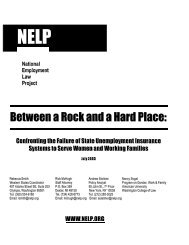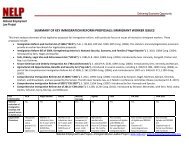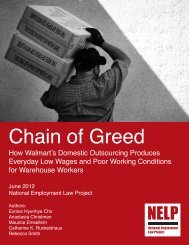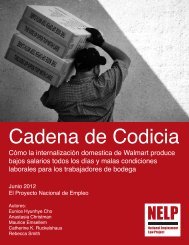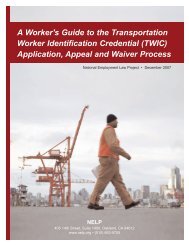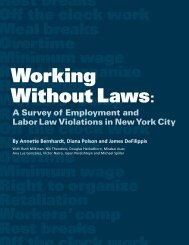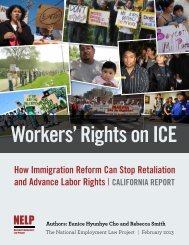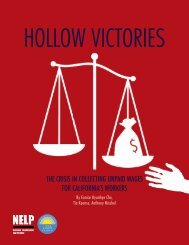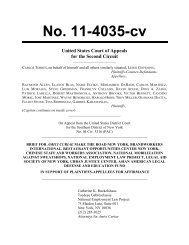Rebuilding Lives. Strengthening Communities.
Rebuilding Lives. Strengthening Communities.
Rebuilding Lives. Strengthening Communities.
Create successful ePaper yourself
Turn your PDF publications into a flip-book with our unique Google optimized e-Paper software.
Internet. This vehicle allows for increased accessibility to<br />
many people, and will enable the database to be updated<br />
and maintained regularly. As with any kind of resource<br />
guide, it runs the risk of becoming obsolete within<br />
months. Consequently, the issue of how, when and who<br />
updates and maintains this resource guide and database<br />
must be dealt with at the outset.<br />
Prisoners could assist with this responsibility. They would<br />
be a consistent and low-cost labor force, and would gain<br />
invaluable job experience at the same time. Additionally,<br />
it would help them learn about organizations, programs<br />
and services available to them after their release. In<br />
Washington, the Correction’s Clearinghouse (CCH)<br />
publishes a Case Management Resource Directory which<br />
lists over 2,500 resources in the state—from free clothing<br />
to substance abuse treatment—that can steer formerly<br />
incarcerated individuals to needed help. CCH coordinated<br />
correctional administrators and local college computer<br />
instructors to devise a prison industry program for<br />
prisoners to assist with designing, editing, maintaining,<br />
producing and distributing the resource directory. 53<br />
The resource guide also could be a practical and informative<br />
tool for either Chicago’s 311 Call Center or a new<br />
toll-free reentry information hotline. The 311 Call Center<br />
is often used by Chicago residents to access non-emergency<br />
and general information about Chicago’s events,<br />
services, and community programs. It handles 3.8 million<br />
calls annually, receiving requests or inquiries and forwarding<br />
them to the appropriate departments. A toll-free<br />
hotline could be established, as an alternative, to provide<br />
callers with information on a wide range of issues,<br />
including treatment centers, housing resources, and<br />
employment agencies. Formerly incarcerated individuals<br />
could contact the 311 Call Center or the toll-free hotline if<br />
they are unsure about where to go for assistance, and the<br />
operators could use the resource guide to provide direction<br />
and guidance.<br />
Expand housing options for formerly incarcerated individuals.<br />
Recommendation<br />
Issue<br />
Housing is one of the most important elements of a<br />
reentry plan for prisoners returning to the community<br />
from prisons and jails, but sometimes a stable housing<br />
option cannot be found by the time an individual is<br />
released. Nationwide, of the approximately 650,000 individuals<br />
released from state and federal prisons annually,<br />
and the seven million individuals released from local jails,<br />
an estimated 10 percent are released into homelessness. 54<br />
For those with mental illness, approximately 20 percent<br />
are homeless in the months before and after<br />
incarceration. 55 In Chicago, approximately 1,200 formerly<br />
incarcerated individuals are discharged from state<br />
prisons to homeless shelters each year because they have<br />
no other place to go at the time of their release. 56<br />
Homelessness, literally being back on the streets, makes it<br />
difficult to comply with parole conditions and contributes<br />
to the cycle of recidivism.<br />
New research has emerged on the relationship between<br />
incarceration and homelessness, which suggests that<br />
“homelessness contributes to a higher risk for incarceration<br />
and that, inversely, incarceration contributes to an<br />
increased risk of homelessness.” 57 Data from a New York<br />
study showed that 6.5 percent of prisoners had used<br />
homeless shelters in the two-year period prior to entering<br />
prison; 45.1 percent of these individuals had subsequent<br />
shelter stays and 42 percent had subsequent prison stays. 58<br />
MAYORAL POLICY CAUCUS ON PRISONER REENTRY<br />
99


